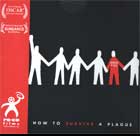
How to Survive a Plague 2012
Distributed by Ro*co Films International, llc, 80 Liberty Ship Way, Suite 5, Sausolito, CA 94965; 415-332-6471
Produced by David France and Howard Gertler
Directed by David France
DVD , color, 85 min.
Sr. High - General Adult
Activism, AIDS/HIV, Health Sciences, Political Science, Social Sciences
Date Entered: 04/10/2013
ALA Notable: yes
Reviewed by Lori Widzinski, Multimedia Collections and Services, University Libraries, University at Buffalo, State University of New York
Beginning in the sixth year of the AIDS epidemic, How to Survive a Plague takes a chronological look at the development of ACT UP (AIDS Coalition To Unleash Power), a grassroots advocacy group formed to address the inadequacies prevalent in the American healthcare system in the 1980s to treat AIDS patients and fight the spread of the disease. The year is 1987, and as the film’s opening screen text notes, the epicenter of the growing anger and concern over the plight of AIDS victims is Greenwich Village in New York City. Amazing footage of the first demonstration at City Hall sets the framework for the film. We have a front row seat to the formation of this historic group through its dynamic founding members—some of whom are no longer with us by the film, and many who survive to provide astounding emotional first-hand accounts of the group’s progression.
Membership in ACT UP increases and so does the passion to fight for cure. They soon take their cause national, demanding answers from the government and the National Institutes of Health as well as the Big Pharma of the time, as to the slow pace of AIDS research. Director David France’s masterful manipulation of primary source footage blends seamlessly with present day commentary footage to create a feeling of urgency as ACT UP strives for a faster answer to their cause. When things start to turn in their favor, the other shoe soon drops, and by the early 1990s, the group’s leaders realize their quest for a speedy cure was shortsighted. The group begins to splinter and their future looks bleak. They continue on and by 1995 they are still advocating for faster FDA approval of AIDS drugs, but are more educated and force researchers to do the right clinical trials. Things start to turn around with the advent of the triple drug combination AIDS cocktail in 1996.
How to Survive a Plague was nominated for a 2013 Academy Award for Documentary Feature and it’s easy to see why. It’s full of stunning moments, such as early on when Iris Long helped provide a research focus for ACT UP; and when a gay man is threatened with eviction from his New York apartment when his long-time partner dies, because only his partner’s name is on their lease—reminiscent of the 2013 Supreme Court hearing on same sex marriage 26 years later. There are startling scenes including footage of Jesse Helms, Pat Buchanan, and a demonstration held during a mass at St. Patrick’s Cathedral. The cinematography, film editing, and outstanding music come to together to create an underlying poignancy, for example watching some of the founding members, like Bob Rafsky, deteriorate and die from the disease, (the scene of his young daughter’s grief at his funeral is heartbreaking) as well as the ending montage of those who survive this plague giving testimony about their fallen comrades and their struggles to deal with survivor guilt. How to Survive a Plague imparts lessons on many levels, the most obvious of which is social activism. While this is one of those films that everyone should see, practical use in the college classroom will depend on it being shown in segments or required for viewing outside of the traditional classroom, based on length alone. Highly recommended for academic and public library collections.